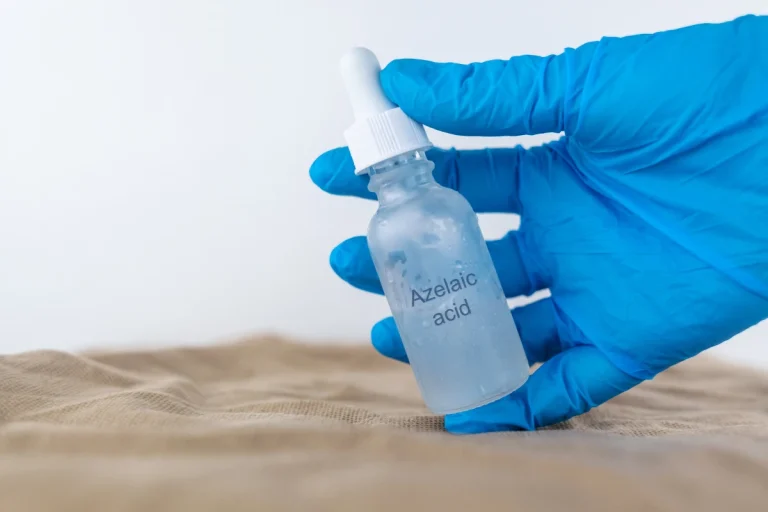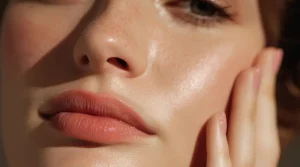Azelaic Acid, also known as “The Unsung Hero,” has recently gained the recognition it deserves. Just a few years ago, it flew under the radar, but now everyone is raving about it like that enthusiastic fish from Spongebob.
Hey, all you people! Hey, all you people! Hey, all you people, won’t you listen to me? I just found an acid! No ordinary acid! An acid filled with beautifying properties!
Let’s clearly and comprehensively discuss all the scientific research on Azelaic Acid! We’ll review every significant study conducted on it and provide product recommendations at the end so you can replicate these studies at home.
Discover Lasting Impression Medical Aesthetics in Fair Lawn, NJ, for further information. Don’t wait any longer! To get started on your path, schedule your appointment right now to more transparent, confident skin!
What is Azelaic Acid?
Good news for natural skincare enthusiasts: Azelaic Acid is a substance that is naturally present in whole grains and is also created by the skin’s microbiome (the healthy bacteria and yeast that live on our skin)(1, 2)
Azelaic Acid is pH-dependent, meaning it requires the right level of acidity to be effective. Ideally, a product containing azelaic acid should have a pH of 4.9, similar to healthy human skin’s pH. If the pH is lower, the product will be less effective. (3)
The typical uses of azelaic acid include treating rosacea, acne, and melasma, and one study also found it effective against psoriasis. (4)
What advantages does Azelaic Acid offer?
Get ready for a detailed dive into its impressive qualities! Azelaic Acid has been extensively researched, revealing numerous benefits. When I stumbled upon it three years ago, it felt like uncovering a hidden gem. As you can see, I’ve stocked up and have gone through several tubes of this remarkable substance. (5)
Azelaic Acid is highly effective in treating Acne!
Consider switching to azelaic acid if you currently use Benzoyl Peroxide for acne treatment. (6)
While Benzoyl Peroxide is undoubtedly effective and has kept my skin clear for many years, it can sometimes be overly harsh and lead to unwanted long-term side effects.
Let’s begin our exploration by comparing azelaic acid with other commonly used acne medications.
Azelaic Acid versus Benzoyl Peroxide: A Comparison.
How does azelaic acid stack up against benzoyl peroxide? Remarkably well, actually. In a study involving 580 participants, subjects were divided into groups receiving either 1% Clindamycin (an antibiotic), 5% Benzoyl Peroxide, or 15% Azelaic Acid were the treatments that were instructed to apply their assigned treatment daily for four months.\
The findings
Clindamycin was disappointing (I’m not a fan of topical antibiotics), while azelaic acid demonstrated effectiveness comparable to benzoyl peroxide. On average, it reduced Acne by about 70% without the negative consequences of benzoyl peroxide.
Azelaic Acid vs. Tretinoin (Retin-A).
Azelaic Acid versus Tretinoin (Retin-A): Comparing Two Powerhouses.
Once more, azelaic acid proves to be nearly identical in effectiveness. A 6-month study with 289 participants discovered that 0.05% Tretinoin and 20% Azelaic Acid cream were deemed “equally effective” against Acne. Like the Benzoyl Peroxide study, the Azelaic Acid cream was better tolerated and didn’t induce the side effects of Tretinoin.
Several research have repeatedly shown the effectiveness of azelaic acid as a treatment for Acne, especially when compared to Benzoyl Peroxide, Tretinoin (Retin-A), and antibiotics. These findings have been replicated since as early as 1982. (7, 8, 9, 10, 11, 12) Additionally, evidence indicates that azelaic acid remains effective in treating adult acne when other treatments have failed. (13)
UPDATE 4/19/19: Recent studies continue to affirm these findings, and there is a growing trend in prescribing azelaic acid for adult female acne.41, 42, 43)
What I find particularly attractive about azelaic acid is its effectiveness against inflammatory Acne, including those large, painful “under the skin” pimples. I still rely on azelaic acid to target and treat any inflammatory lesions that may arise.
Regrettably, many acne treatments, such as retinoids (e.g., Differin, also known as adapalene), primarily serve as preventive measures targeting comedonal Acne. In simpler terms, they prevent your pores from clogging, reducing Acne over time. However, they may not effectively address the large cystic pimples that are already present — a job for azelaic acid!
And now, for the grand finale…
Azelaic Acid versus Accutane: A Comparison.
I was beyond excited when I came across this study! 😀 This clinical trial enrolled 85 participants with severe Acne, who were randomly assigned either Accutane or a 20% Azelaic Acid cream to be used alongside Minocycline (another antibiotic).
After six months, the patients using the Azelaic Acid-antibiotic combination were utterly free of cystic Acne! Additionally, they experienced an 88% decrease in whiteheads and blemishes and a 70% reduction in clogged pores. It’s remarkable.
Accutane patients also achieved complete clearance of cystic Acne, with a notable 97% reduction in whiteheads and blemishes and an 83% reduction in clogged pores. So, while the Azelaic Acid-antibiotic group didn’t outperform Accutane, they still showed significant improvement in comparison.
Remember that we’re discussing Accutane, the most potent acne medication available. Performing against it is impressive. The researchers conducting this study concurred, concluding that Azelaic Acid is an exceptionally effective treatment for severe Acne. They considered it a valuable alternative to Accutane, boasting fewer risks and better tolerability.
What is the mechanism of action of Azelaic Acid in treating Acne?
Azelaic Acid exhibits antibacterial, anti-inflammatory, and anti-keratinizing properties. This means it not only combats bacteria and reduces inflammation but also prevents the accumulation removing dead skin cells, decreasing the possibility of obstructed pores and breakouts.
Unlike Accutane, Azelaic Acid doesn’t alter the sebum your skin produces. Instead, it reduces the free fatty acid content in the skin, creating an environment less conducive to bacterial and fungal overgrowth.
UPDATE 4/11/17: This indicates that Azelaic Acid is also efficacious in treating “fungal acne,” or skin conditions linked to Malassezia, such as seborrheic dermatitis, pityrosporum folliculitis, dandruff, eczema, and psoriasis. Skin areas exposed to pathogenic Malassezia tend to have elevated levels of free fatty acids.
Relative composition of human sebum
As secreted Post Malassezia exposure Post antifungal treatment
Relative composition of human sebum
As secreted Post Malassezia exposure Post antifungal treatment
Triglycerides >35 18 32
Free fatty acids <13 32 16
Wax esters 25 23 25
Squalene 15 15 15
Cholesterol 3 3 3
Cholesterol 4 4 4
esters
others ~5 ~5 ~5
Source: Investigating the Role of Sebaceous Gland Activity and Scalp Microfloral Metabolism in Developing Seborrheic Dermatitis and Dandruff. (41)
One of the mechanisms through which antifungals combat the mentioned skin conditions is by regulating the free fatty acid levels in the skin. Azelaic acid has been demonstrated to achieve precisely this. A study discovered that after one month of using azelaic acid, the levels of free fatty acids decreased from 15.9% to 10.5%. (16, 17, 18, 19)
It might sound convoluted, but consider this analogy: imagine a zombie apocalypse hits, and food is scarce. Acne represents the starving person, and Azelaic Acid acts as the farmer. However, instead of feeding the starving person, the farmer tells them to leave, resulting in their demise.
Alright, maybe not the best analogy… but you catch my drift! Essentially, azelaic acid creates an environment where acne and Malassezia-induced skin conditions struggle to survive due to lack of sustenance.
Azelaic Acid Treats Rosacea.
What is Rosacea?
For those unfamiliar, rosacea is a chronic skin condition characterized by erythema or dilated capillaries (tiny blood vessels), resulting in an overall appearance of redness. (20)There are four types of Rosacea, but the primary ones are subtype one and subtype 2. (21)
Subtype 1 is primarily characterized by superficial facial redness and is often referred to interchangeably as “coupe rose skin.” Subtype 2, known as papulopustular rosacea, includes papules and pustules (i.e., pimples and whiteheads) and facial redness.
Studies
Despite Azelaic Acid’s notable efficacy The FDA has authorized it as a therapy for Rosacea, but not for acne. In a study, 15% Azelaic gel demonstrated the ability to manage papulopustular rosacea over six months by significantly reducing erythema and inflamed lesions. (22)
Combining antibiotics with 15% Azelaic Acid gel has been found to enhance its effectiveness in treating papulopustular rosacea. (23, 24).
How it works against Rosacea is a mystery. Scientists haven’t figured it out yet, but they I believe its antibacterial, antioxidant, and anti-inflammatory qualities have something to do with it. (no surprise there :p). (23, 24).
Azelaic Acid Addresses Hyperpigmentation and Melasma
What is Melasma?
Melasma is a skin condition triggered by excessive melanin production, leading to brown discolorations on the skin, often resembling hyperpigmentation. (26) Exposure to sunlight exacerbates this condition. So, it’s crucial to use sunscreen! Yes,
Azelaic Acid vs. Hydroquinone?
If you’re unaware, hydroquinone is a standard treatment for hyperpigmentation and melasma. It inhibits melanin production and is available over the counter in concentrations up to 2%. Higher concentrations necessitate a doctor’s prescription. (27)
There has been controversy regarding the long-term safety of hydroquinone in the past, notably stemming from a 1991 study suggesting it could promote tumor growth in mice. However, this study had a few issues; for instance, the mice were orally administered 0.8% hydroquinone rather than applied topically.
Despite this, hydroquinone has been prohibited in South Africa, Japan, Australia, and the European Union. (28) Some skincare experts and companies, notably Paula’s Choice and FutureDerm, dispute this assessment. However, I’ll leave it to you to form your opinion.
If you prefer to avoid the controversy altogether, consider using Azelaic Acid! Several studies have indicated that hydroquinone is more effective than 4% in treating hyperpigmentation without the associated unwanted side effects. (29, 30)
One of the most extensive studies, spanning 24 weeks and involving 329 women, concluded that “no significant treatment differences” existed between the two options. Moreover, azelaic acid exhibited absence of serious adverse effects, such as allergic sensitization or exogenous ochronosis, which are uncommon but potential outcomes of prolonged hydroquinone use. (31)
Azelaic Acid is Good For Hair Growth.
The pairing of zinc sulfate and azelaic acid has demonstrated efficacy in inhibiting DHT, rendering it an effective remedy for hair loss. Hence, it’s common to find Rogaine (Minoxidil) products containing azelaic acid variations.
Hold on. I’ve heard that azelaic acid causes hair loss.
I’ve encountered a few assertions like this, but they’re only partially accurate and often stem from misunderstanding the mechanisms behind hair loss. Let me clarify.
Dihydrotestosterone (DHT) is the culprit behind Also referred to as male or female pattern baldness, androgenetic alopecia. However, the same hormone stimulates facial hair growth in men. In essence, the hormone responsible for balding is also accountable for beard growth in men.
That’s why you’ll frequently encounter men with substantial beards who are also experiencing baldness. If this is the first time you notice this connection, you have something new to ponder!
The Takeaway
Azelaic acid is beneficial for combating hair loss on the scalp but may lead to slight beard thinning. However, this thinning is usually mild and barely noticeable to most individuals. As far as I’m aware, only one study has documented this, and it was a rare exception.
So, ladies. If you’re worried about growing a beard, incorporating some azelaic acid into your routine shouldn’t cause any harm.
Summary of all the benefits
Azelaic Acid is a highly potent acne treatment, rivaling the effectiveness of Benzoyl Peroxide, Tretinoin, and even Accutane. Additionally, it effectively addresses rosacea, melasma, and hyperpigmentation concerns.
Its antibacterial, antioxidant, and anti-keratinizing properties work together tTo avoid the accumulation of dead skin cells, unclog pores, and diminish redness. Most importantly, it achieves these benefits gently without causing significant side effects. Furthermore, there’s evidence suggesting its potential efficacy in treating hair loss.
Side Effects
As you’ve likely gathered, there are only a few significant drawbacks to using Azelaic Acid. This versatility is what makes it so exceptional. It addresses numerous skin concerns without the irritation often associated with other topical prescriptions and ingredients.
To recap some key points: Azelaic acid poses minimal risk and is non-toxic and non-teratogenic (meaning it doesn’t cause congenital disabilities like Accutane). It boasts excellent tolerability, doesn’t promote bacterial resistance, and doesn’t increase sensitivity to sunlight (which could worsen sun-related side effects). (34, 35)
When adverse effects do arise, they are usually minor. such as stinging or burning upon application and skin dryness. (36) However, Azelaic acid doesn’t compromise the skin barrier or lead to transepidermal water loss (TEWL), meaning it doesn’t strip the skin of moisture. (37)
Using Azelaic Acid: Tips and Guidelines
Apply approximately a fingertip’s worth of Azelaic Acid to cover the entire face after cleansing. If you experience irritation, consider buffering it by applying moisturizer first. This won’t compromise its effectiveness and can help minimize unnecessary irritation.
Start slowly and conduct a patch test before the entire application. Remember, more isn’t always better. A study discovered showed using a lotion containing 20% azelaic acid thrice a day was equally as effective as using it twice daily after three months. (38)
Choose 15% Azelaic Acid gel over the cream formulation. The gel typically contains lower lipid concentrations, reducing the need for additional emulsifiers and potentially irritating ingredients.
Moreover, the gel form offers enhanced penetration. A study involving mice demonstrated an 8-fold increase in delivery compared to the cream version. (39) the gel is more potent and less likely to irritate.
When can I expect to see results?
Results typically manifest pretty promptly. In a year-long study encompassing 1,200 patients using 15% Azelaic Acid gel, 81.9% of dermatologists observed an improvement in Acne after just 35 days, a figure that surged to 93.9% after 73 days. Of the patients, about 80% said they were “very satisfied” with their treatment by the study’s conclusion. (40)
Where can I locate Azelaic Acid?
Azelaic acid is a prescription medication, so it is challenging to obtain, especially without a dermatologist. While I hope to avoid causing any trouble by mentioning this, you may find it available on specific online marketplaces.
Two primary brands are commonly sold: 20% Skinoren cream and 15% Finacea gel. It’s worth noting that the names Skinoren and Finacea are used interchangeably; they represent the same brand. The crucial distinction lies in the preferred variation (cream or gel). If you reside in the U.S., shipping may take longer due to overseas shipments.






